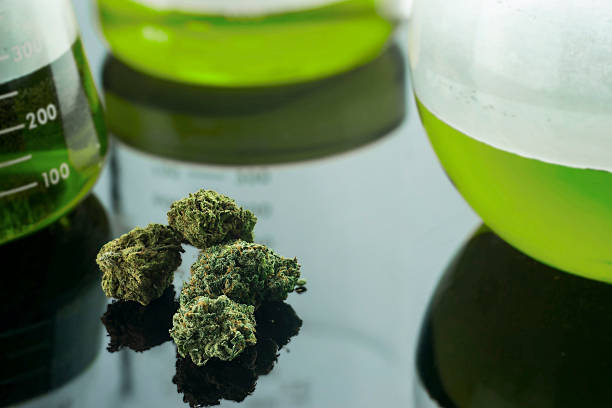

When it comes to growing cannabis, one of the most important decisions you'll need to make is choosing the right strain for your grow. The strain you choose can have a significant impact on the success of your crop, so it's essential to do your research and select a variety that will thrive in your specific growing conditions.
There are hundreds of different strains of cannabis available, each with its own unique characteristics and growth requirements. Some strains are better suited for indoor grows, while others may be more suitable for outdoor cultivation. Factors such as climate, space, lighting, and nutrient availability all play a role in determining which strain will be the best fit for your grow.
It's also important to consider what type of effects you're looking for in your final product. Some strains are high in THC and produce a strong psychoactive effect, while others are higher in CBD and offer more medicinal benefits. By choosing a strain that aligns with your desired outcome, you can ensure that you're growing cannabis that meets your specific needs.
Ultimately, selecting the right strain for your grow is a personal decision that requires careful consideration and planning. By taking the time to research different varieties and understand their unique characteristics, you can set yourself up for success and cultivate high-quality cannabis plants that exceed your expectations.
Setting up a proper growing environment for your cannabis plants is essential to ensure they thrive and produce high-quality buds. There are several key factors to consider when creating the perfect space for your plants.
First and foremost, lighting is crucial for the growth of cannabis plants. Whether you choose natural sunlight or artificial grow lights, it's important to provide your plants with the right amount of light during each stage of their growth cycle. Make sure to monitor the intensity and duration of light exposure to prevent any potential issues such as light burn or nutrient deficiencies.
Next, temperature and humidity levels play a significant role in the overall health of your plants. Cannabis thrives in temperatures between 70-85 degrees Fahrenheit and humidity levels around 40-60%. It's important to invest in a good quality thermometer and hygrometer to monitor these conditions regularly and make adjustments as needed.
Proper ventilation is also essential for maintaining a healthy growing environment. Adequate air circulation helps prevent mold, mildew, and pests from taking hold in your garden. Consider investing in fans or an exhaust system to ensure fresh air is constantly circulating around your plants.
Lastly, don't forget about nutrients and watering schedules. Cannabis plants require specific nutrients at different stages of their growth cycle, so it's important to research which fertilizers will best suit your needs. Overwatering can lead to root rot, so be sure to water your plants only when needed and allow the soil to dry out slightly between waterings.
By paying attention to these key factors and setting up a proper growing environment, you'll be well on your way to successfully cultivating healthy cannabis plants that yield potent buds. Remember that every grow space is unique, so don't be afraid to experiment and adjust as needed until you find what works best for you and your plants.
Are you looking to take your cannabis cultivation skills to the next level?. Are you ready to boost your harvest and produce top-quality buds that will impress even the most discerning connoisseurs?

Posted by on 2024-05-30
Pests can be a real nuisance in our homes and gardens, causing damage to our property and spreading diseases.. It is important to take proactive measures to prevent pest infestations and protect ourselves from potential health risks.
One way to tackle this issue is by seeking expert advice on pest control and disease prevention strategies.

Posted by on 2024-05-30
If you've ever dreamed of growing your own cannabis plants, then you're in luck!. With the right knowledge and guidance, you can discover the secrets of successful cannabis growing and become a pro in no time.

Posted by on 2024-05-30
Understanding the nutrients and feeding schedule is crucial when it comes to successfully growing cannabis plants. Just like any other living organism, cannabis plants require a balanced diet of essential nutrients to thrive and reach their full potential.
Nutrients play a vital role in the growth and development of cannabis plants, affecting everything from root development to flower production. By understanding which nutrients are necessary for each stage of growth, cultivators can ensure that their plants have everything they need to flourish.
Creating a feeding schedule is key to providing your cannabis plants with the right amount of nutrients at the right time. This involves carefully monitoring the plant's progress and adjusting nutrient levels accordingly. Overfeeding or underfeeding can have negative consequences on plant health, so it's important to strike a balance and provide just what the plant needs.
By taking the time to understand the specific nutrient requirements of cannabis plants and creating a customized feeding schedule, growers can optimize their yields and produce high-quality buds. With proper care and attention to detail, cultivating healthy cannabis plants can be a rewarding experience for any grower.
Managing light cycles and humidity levels are two crucial aspects of successfully growing cannabis plants. Light cycles refer to the amount of light a plant receives in a 24-hour period, while humidity levels pertain to the amount of moisture in the air.
For indoor growers, controlling light cycles is essential for mimicking natural sunlight and promoting healthy growth. Cannabis plants require specific periods of darkness and light to thrive, with most growers opting for an 18/6 or 12/12 light cycle during different stages of plant development. By managing light cycles effectively, growers can encourage proper flowering and maximize yields.
Humidity levels also play a significant role in cannabis cultivation. Too much moisture in the air can lead to mold and mildew growth on plants, while low humidity levels can cause stress and stunted growth. Maintaining an optimal humidity level between 40-60% is ideal for most strains of cannabis.
By monitoring and adjusting both light cycles and humidity levels, growers can create an optimal environment for their plants to flourish. This attention to detail ensures that cannabis plants receive the necessary conditions for healthy growth and high-quality yields.
Pruning and training techniques are essential practices when it comes to maximizing the yield of your cannabis plants. By selectively removing certain parts of the plant, you can encourage it to grow in a way that will result in larger and more potent buds.
One common technique is topping, where you remove the top growth of the plant to encourage lower branches to grow upwards. This can help create a more even canopy and ultimately lead to a higher overall yield. Another popular method is LST (low stress training), where you gently bend and tie down branches to create a more horizontal growth pattern. This allows for better light penetration and can also increase bud production.
In addition to pruning and training techniques, it's important to stay on top of nutrient levels, watering schedules, and environmental factors like temperature and humidity. By paying attention to all these elements, you can ensure that your cannabis plants are receiving everything they need to thrive and produce an abundant harvest.
Overall, by employing proper pruning and training techniques alongside other best practices, you can maximize the yield of your cannabis plants and enjoy bigger, better buds come harvest time.
Monitoring plant health and pest control are essential practices in cannabis growing techniques. As a grower, it is important to regularly inspect your plants for any signs of distress or infestation.
One of the most common ways to monitor plant health is by examining the leaves. Discoloration, spotting, wilting, or yellowing can all be indicators of nutrient deficiencies or diseases. By closely observing your plants, you can identify issues early on and take corrective action before they become more serious.
Pest control is another crucial aspect of cannabis cultivation. Pests such as spider mites, aphids, and caterpillars can wreak havoc on your plants if left unchecked. Regularly checking for signs of pests – such as webbing, holes in leaves, or insect sightings – can help you catch infestations early and prevent them from spreading.
There are several methods for controlling pests in a cannabis garden, including using natural predators like ladybugs or releasing beneficial nematodes into the soil. Additionally, organic pesticides derived from botanical oils or neem oil can be effective at keeping pests at bay without harming the plant itself.
In conclusion, monitoring plant health and pest control are critical components of successful cannabis cultivation. By staying vigilant and proactive in these areas, growers can ensure their plants thrive and produce high-quality yields. Remember that prevention is key when it comes to maintaining a healthy garden – so keep a close eye on your plants and address any issues promptly to keep them happy and thriving.
Harvesting, drying, and curing your cannabis plants are crucial steps in the cultivation process that can greatly impact the quality of your final product.
When it comes to harvesting, timing is everything. You'll want to wait until the trichomes on your plants have turned a milky white color before you start harvesting. This will ensure that the THC levels are at their peak and that you're getting the most potent buds possible.
Once you've harvested your plants, it's time to dry them. Proper drying is essential for preserving the flavor and potency of your cannabis. Hang your plants upside down in a cool, dark room with good airflow for about 7-10 days. Make sure to check on them regularly and adjust humidity levels as needed to prevent mold growth.
After your plants are dried, it's time to cure them. Curing involves storing your buds in airtight containers like mason jars and burping them daily to release excess moisture. This process can take anywhere from 2-8 weeks but will result in a smoother smoke and more flavorful experience.
By taking care during these three stages of cannabis cultivation, you'll be rewarded with high-quality buds that deliver an exceptional smoking experience. So don't rush through these steps – take your time and enjoy the fruits of your labor!